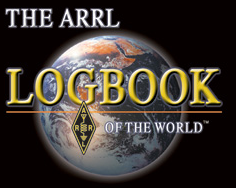Confirmation process
The LoTW system uses "secure" authentication using cryptographic key distribution. An amateur's computer-based logbook, in ADIF [2] or Cabrillo [3] format, have to be "signed" using a key obtained from ARRL. (Logbook data includes callsigns and locations of stations, contact time, frequency, and operating mode.) ARRL assigns such keys to amateurs who appear in the U.S. FCC licensing database or to non-US amateurs who provide alternate proof of identity.
Once a log file is signed using ARRL's "TrustedQSL" (or equivalent) program, it is uploaded to the ARRL server and entered in the database.
Log records in the LoTW database are automatically compared so that when a contact at a particular time, operating mode, and frequency band is claimed by both participating amateurs (both of whom must have submitted their logs), a "QSL" (confirmation) is declared for a later award claim, e.g., for contacts with all U.S. states or 100 different countries. The matching process is blind, meaning that neither of the two stations can see pending confirmations before they uploaded a matching record. The LoTW QSL is purely electronic; there are no paper confirmations. However, a participant is able to print out a record of each confirmed contact, complete with its LOTW record number.
A LoTW-registered amateur is able to log into the LoTW website to view their logged QSOs and the verified QSL matches. When the amateur obtains a sufficient number of LoTW and/or traditional paper QSLs, they are able to apply for an ARRL award. As of January 2012, LoTW credit could be used for credit for awards issued by the ARRL and by CQ Magazine. The ARRL does not recognize other web-based QSL systems, such as eQSL, [4] for awards credit.
This page is based on this
Wikipedia article Text is available under the
CC BY-SA 4.0 license; additional terms may apply.
Images, videos and audio are available under their respective licenses.
